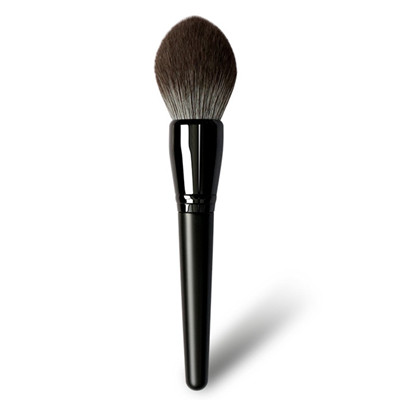Main brush handle printing processes
| Process Name | Technical principle | Applicable materials | Effect characteristics | Durability | Applications |
| Laser Engraving | High-energy lasers ablate surfaces to form patterns | Metal, wood, acrylic | Permanent engraving, matte/glossy finish optional, ink-free | Very high (never falls off) | High-end professional lines (such as Sigma metal handles) |
| Pad Printing | The silicone tip is dipped into the ink and transferred to the curved surface | Plastic, metal, resin | Bright colors, can print complex patterns, slightly blurred edges | Medium (wear-resistant for 3-6 months) | Cheap plastic handles |
| UV inkjet printing | UV curable ink direct printing | ABS plastic, aluminum | High-precision image, mirror gloss, strong adhesion | High (alcohol wipe resistance) | Mid-range line (such as acrylic handle) |
| Water transfer printing | Hydrolytic film pattern wrapping curved surface | Special-shaped brush handle (such as wavy pattern) | Fully covered pattern, gradient/3D effect, smooth touch | Low (easy to wear and fade) | Limited edition co-branded |
| Electroplating paint | Etched grooves filled with colored paint | Stainless steel, brass | Metallic luster + colorful LOGO, luxury texture | Very high (more than 10 years) | Top quality handmade brush |
| Thermal transfer | High temperature and pressure transfer pattern film | Plastic, bamboo and wood | The pattern is clear, but easily deformed by heat | Medium (scratch resistance 1 year) | Low-end wooden handle |
Process selection suggestions
High-end line: laser engraving/electroplating (process cost accounts for 10%-15%)
Mid-end line: UV inkjet printing/water transfer printing (process cost accounts for 3%-8%)
Affordable line: pad printing/thermal transfer printing (process cost accounts for 1%-5%)
Mid-end line: UV inkjet printing/water transfer printing (process cost accounts for 3%-8%)
Affordable line: pad printing/thermal transfer printing (process cost accounts for 1%-5%)
Process details
1. Laser engraving
Technical points:
Deep engraving (0.2-0.5mm) is suitable for metal/solid wood, shallow engraving (0.1mm) for acrylic.
Avoid too thin lines (<0.3mm), easy to break and unclear.
Deep engraving (0.2-0.5mm) is suitable for metal/solid wood, shallow engraving (0.1mm) for acrylic.
Avoid too thin lines (<0.3mm), easy to break and unclear.
2. UV inkjet printing
Advantages:
Supports Pantone special colors, color difference ΔE<1.5 (industry standard ΔE<3).
Can make local varnish bulges (such as tactile 3D LOGO ).
Notes: 3D positioning is required for curved surface printing, inferior equipment is prone to faults.
Supports Pantone special colors, color difference ΔE<1.5 (industry standard ΔE<3).
Can make local varnish bulges (such as tactile 3D LOGO ).
Notes: 3D positioning is required for curved surface printing, inferior equipment is prone to faults.
3. Water transfer printing
Applicable designs: Complex patterns such as marble, camouflage, and starry sky.
A protective varnish layer is required, otherwise the wear resistance is only 3 months.
Cost: The pattern complexity determines the price.
Environmental protection and certification considerations
Ink type
Water-based ink: VOCs emissions are reduced by 70%, but the adhesion is weaker than solvent-based (UV curing is required for enhancement).
Plant-based ink: Soy ink is suitable for paper packaging, and brush handle printing is still mainly UV.
Plant-based ink: Soy ink is suitable for paper packaging, and brush handle printing is still mainly UV.
International certification
REACH: Ensure no SVHC (substances of very high concern) in the ink, a must for the EU market.
LFGB: Food-grade contact safety certification, suitable for brush handles that may contact the lips.
LFGB: Food-grade contact safety certification, suitable for brush handles that may contact the lips.
Cost Optimization Strategy
Bulk Pricing
Laser Engraving: $0.7/pcs for 1,000pcs, $0.25/pcs for 10,000pcs and above.
Pad Printing: $0.1/pcs for 5,000pcs, $0.07/pcs for 50,000pcs and above.
Process CombinationPad Printing: $0.1/pcs for 5,000pcs, $0.07/pcs for 50,000pcs and above.
High Cost-effectiveness: Laser Engraving LOGO + UV Spraying Gradient Background (Total Cost $1/pcs).
Light Luxury Design: Water Transfer Printing + Partial Hot Stamping (Total Cost $0.7/pcs).
Light Luxury Design: Water Transfer Printing + Partial Hot Stamping (Total Cost $0.7/pcs).
Future Trends
Smart induction printing:
Thermostatic ink (color changes when exposed to body temperature) prompts cleaning cycle.
3D printing fusion:
Directly print color stereo patterns without transfer (the cost is currently high, about $3/pcs).
Zero pollution process:
CO2 laser engraving (no smoke and dust), suitable for environmentally friendly brands.
Thermostatic ink (color changes when exposed to body temperature) prompts cleaning cycle.
3D printing fusion:
Directly print color stereo patterns without transfer (the cost is currently high, about $3/pcs).
Zero pollution process:
CO2 laser engraving (no smoke and dust), suitable for environmentally friendly brands.
Summary: The brush handle is the brand name card
To users: The texture of the craftsmanship directly affects the "first impression after unboxing" and the decision to repurchase.
To channels: High-end craftsmanship increases the priority of shelf display (such as Sephora's strict review of craftsmanship).
To cost: Reasonably allocate the craftsmanship budget to avoid excessive design squeezing profits.
To channels: High-end craftsmanship increases the priority of shelf display (such as Sephora's strict review of craftsmanship).
To cost: Reasonably allocate the craftsmanship budget to avoid excessive design squeezing profits.
Suggestions:
Test at least 3 crafts in the sampling stage and compare the physical texture and cost.
Sign a wear test agreement with the makeup brush manufacturers (such as alcohol wiping 500 times without fading).
Sign a wear test agreement with the makeup brush manufacturers (such as alcohol wiping 500 times without fading).
From the printing details of a brush handle, customers can see the brand's persistence in quality, precise craftsmanship makes the makeup brush an aesthetic expression.







